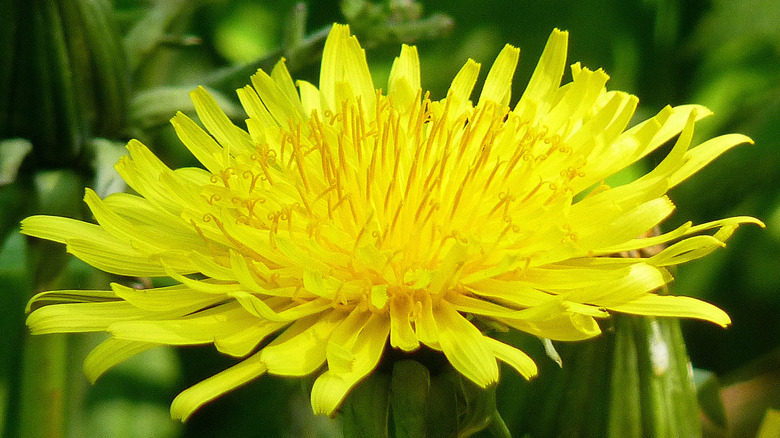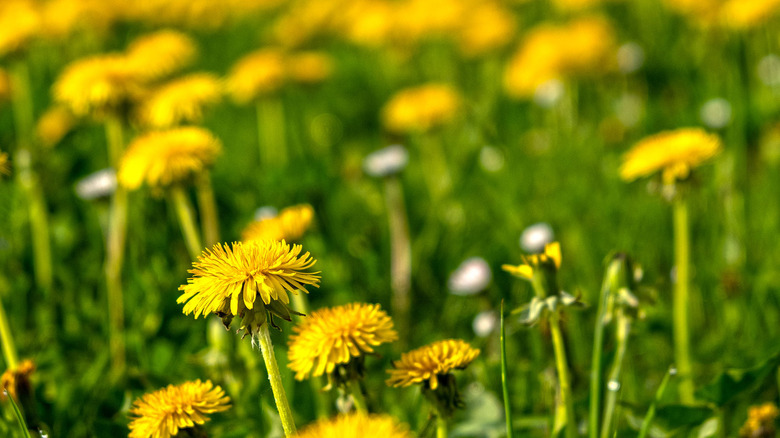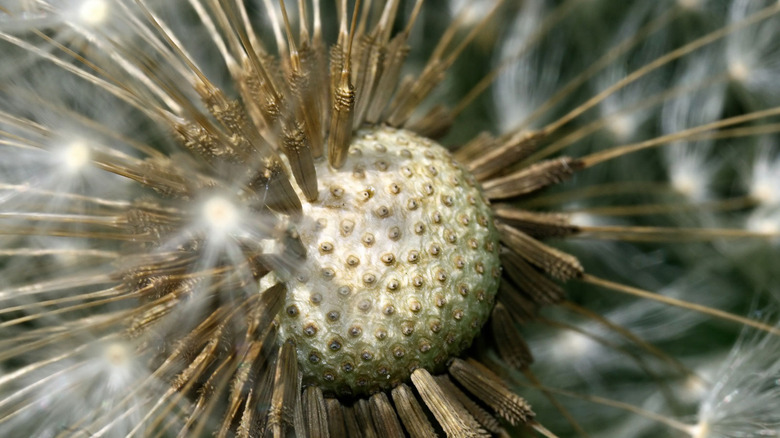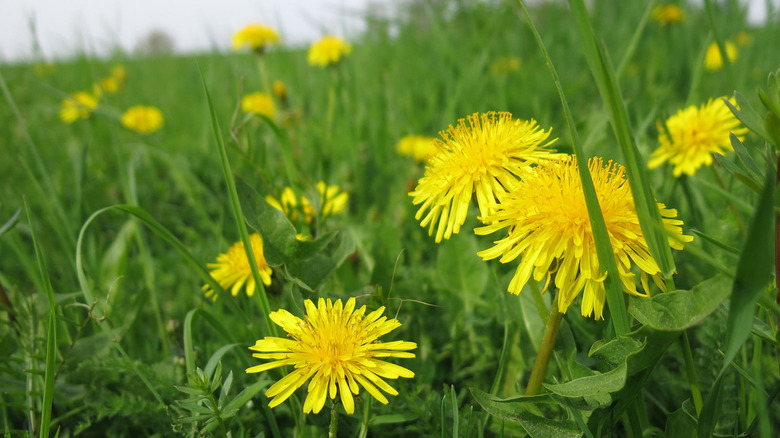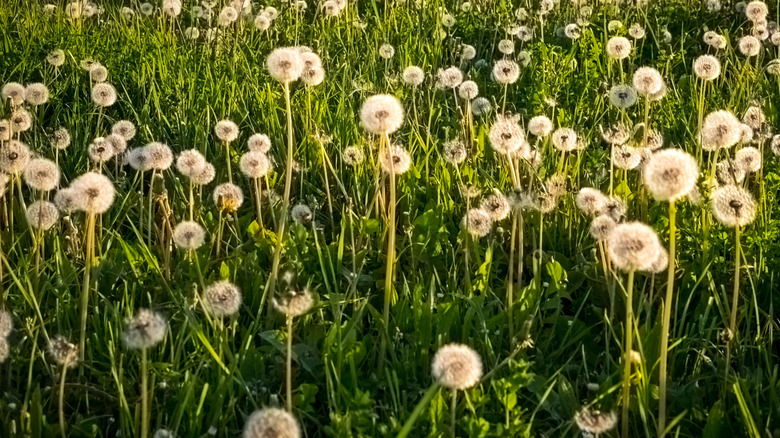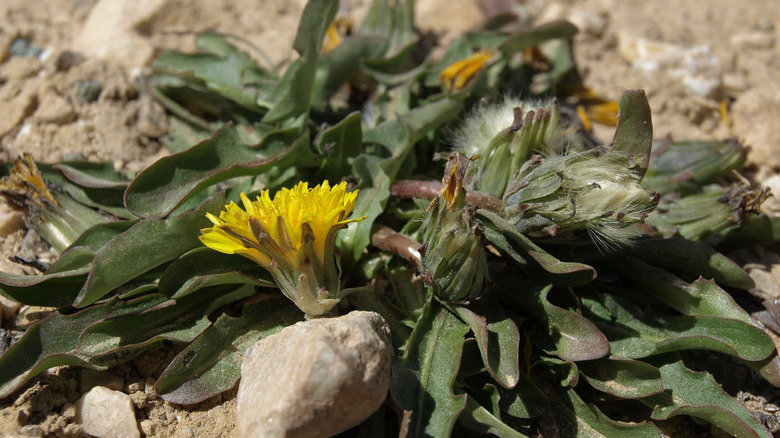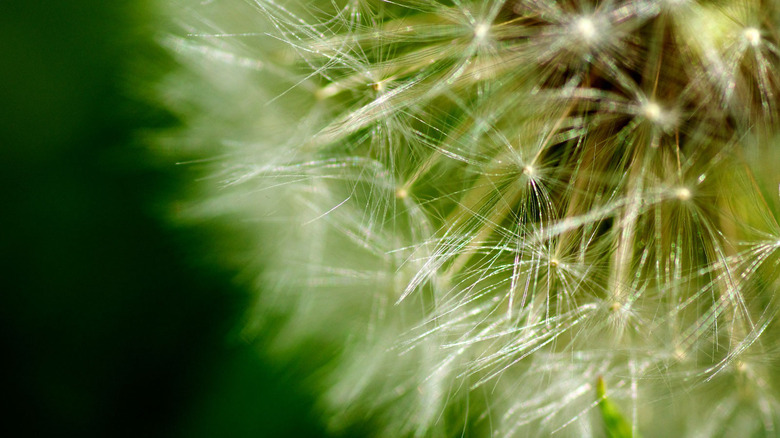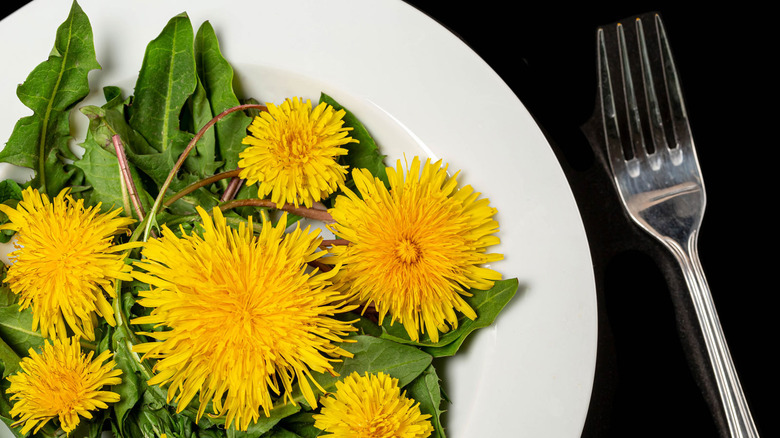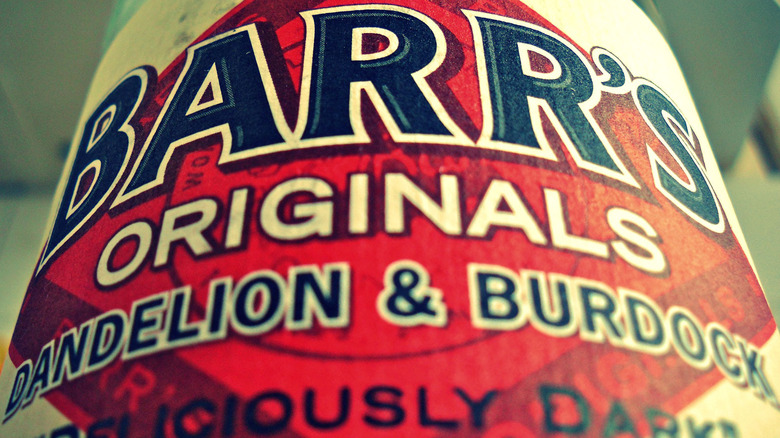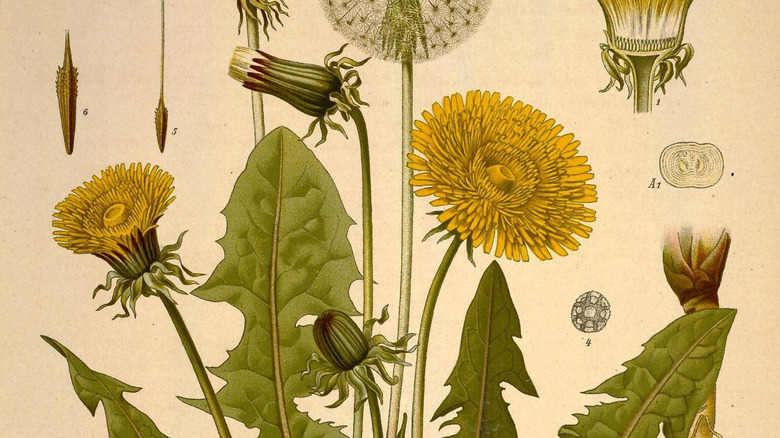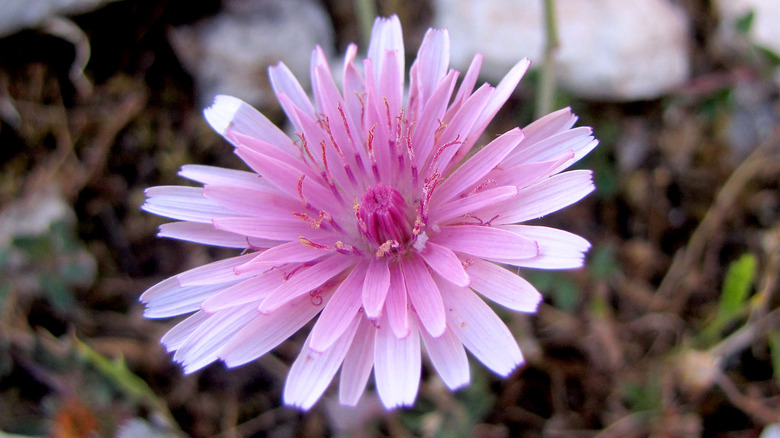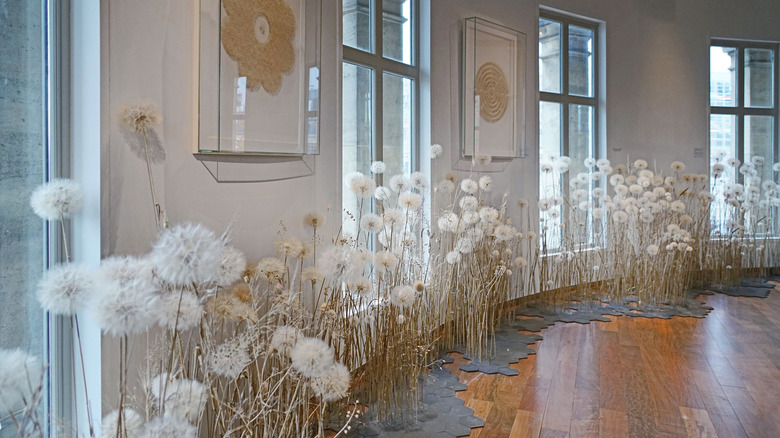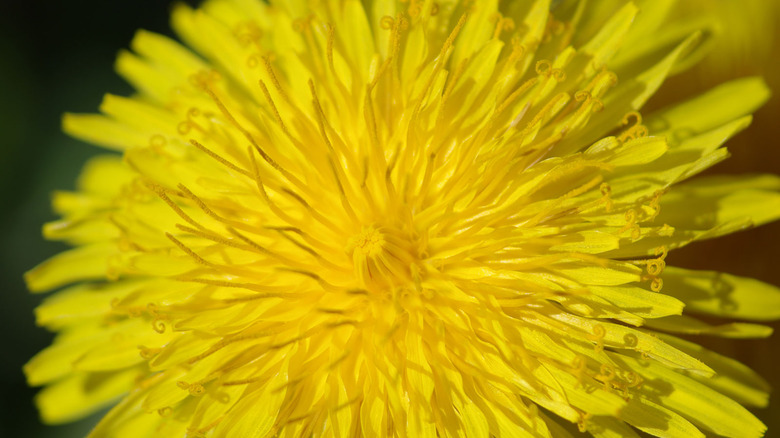The Untold Truth Of Dandelions
Every springtime, grassy areas everywhere start bristling with vibrant yellow flowers. Inevitably, the buzzing of bees is soon replaced by the buzzing of lawnmowers as people work to maintain manicured lawns of pure green grass. However, those humble but ubiquitous dandelions are overlooked and underrated jewels hiding right under our very noses, as beautiful as they are helpful.
The name dandelion, as Gardening Know How explains, actually comes from the French name, dent de-lion, meaning "lion's tooth." It name refers to the serrated shape of the plant's leaves, rather than the vibrant flowers that bloom each spring, with their golden manes. Those flowers, though, are worth their weight in gold to pollinators like bees and butterflies, who make the most of dandelions as an important source of nectar.
While many people dismiss dandelions, seeing them all as the same kind of weed, they hide surprising complexity. There are over 250 distinct dandelion species, from the white Japanese dandelion to the pink dandelions of central Asia, to the California dandelion which grows in the San Bernadino Mountains. Many others, however, are difficult to tell apart. In fact, as a botany study published in PeerJ notes, there are around 2,800 microspecies of dandelion — small, localized populations of plants with subtle differences from each other. The Botanical Society of Britain and Ireland talks about how a single area may easily contain 80-100 dandelion species. And all of this quiet complexity is just the tip of the iceberg of unspoken dandelion knowledge.
Dandelions are good for your garden
Yes, you read that correctly. Despite all of the efforts made to poison or uproot dandelions, they can be extremely beneficial for gardeners and lawns alike! Dandelion expert Anita Sanchez at the Maine Organic Farmers and Gardeners Association has plenty to say about this, explaining how dandelion roots grow deep and spread wide. While this makes them difficult to dig up, it also allows dandelion roots to loosen hard-packed soil, aerate the earth, and help prevent soil erosion — all things which will greatly benefit any other plants growing nearby. Even better, those deep roots pull up nutrients from well below the surface layers of soil, which many other plants can't reach. Simply put, dandelions actually help the grass around them to grow.
The book, "Weeds: Guardians of the Soil" discusses this in much more detail, noting how dandelions can benefit crops being grown in gardens. Making trace elements available to other plants is one of the dandelions' most important jobs. In fact, the plants which gardeners dismiss as weeds can act as indicators of soil quality, only appearing when they're needed to fix problems, like nutrient deficiencies. Weeds like dandelions can even be used as "mother crops," growing as companion plants alongside domesticated plants, to help nurture them.
Dandelions weren't always called weeds
It's only recently that people have started to consider dandelions as weeds, and, botanically speaking, this is a highly subjective label. As Britannica explains, a weed is simply a plant growing somewhere that humans don't want it. Historically, however, dandelions have been anything but unwanted.
A study in the Journal of Ethnopharmacology talks about the traditional uses of dandelions in some detail. They can be eaten but, more importantly, they've been used by a wide variety of cultures as a medicine. The scientific name for the dandelion genus is Taraxacum, which comes from the Greek words "taraxis" and "akomai," meaning "inflammation cure". The medicinal uses of dandelions go back a millennium, with some of the earliest known records coming from Arabian physicians. They've been used in traditional medicine by Native American, Chinese, and European doctors alike.
The change in attitude towards dandelions only happened sometime in the 20th century, as the Maine Organic Farmers and Gardeners Association explains, when people made the relatively sudden decision that dandelions were no longer welcome. Since then, these plants have become deeply unpopular. As a result, people have used herbicides to kill them en masse, but this has come with a terrible toll on wildlife. In pursuit of weed-free lawns, homeowners in America use up to 10 times as much pesticide per acre as farmers use on commercial crops. And according to the U..S Forest Service, these pesticides kill millions of wild birds every year.
Dandelions are 'weeds' because of lawns
Lawns, as it happens, are largely to blame for the bad reputation dandelions now carry. According to West Coast Seeds, carefully managed lawns inadvertently create the ideal conditions for dandelions to grow, compacting the soil. A wide-open lawn is practically an invitation for dandelions to take root. Dandelions are a pioneer species, repairing disturbed land, as an information sheet from the U.S. Forest Service explains. They grow in places where the land has been damaged, where other plants have been killed off by overgrazing, which looks virtually the same as a short-mown lawn to a dandelion.
The enthusiasm for lawns actually stems from some rather old-fashioned thinking. In 17th-century England, a pristine lawn was a show of wealth, with large estates hiring teams of gardeners to care for their lawns by hand. WTTW News mentions how this was also at a time when most people were actively growing their own food. In other words, growing nothing but grass was a twofold status symbol — simultaneously a show that someone could not only keep unproductive land but hire people to maintain it. The modern desire for suburban housing to have well-kept lawns seems to be a hangover from this old association between grassy lawns and status. Dandelions throw a wrench into the works, growing enthusiastically wherever they find a lawn but, as a page from Columbia University explains, they're quite benign. Controlling them is purely a matter of aesthetics.
Dandelions arrived in the Americas before Europeans
Even many gardening enthusiasts consider dandelions an invasive species in North America, treating them all as pests to be removed. The reality, though, is slightly more complicated. It's certainly the truth that the common dandelion species which now grow prolifically in America are an introduced species from Europe. However, it isn't the entire truth.
For a start, while there are stories about dandelions being introduced accidentally, the fact is that the first European settlers brought dandelions to the Americas on purpose. As WTTW News explains, the plants were first introduced sometime during the 1600s, when colonists would plant them in their gardens as food and medicine. Unbeknownst to the Europeans, however, dandelions were living in North America long before they were.
An article by Valerie Goodness for Indian Country Today discusses this in plenty of detail, noting how the idea that dandelions only arrived with Europeans is revisionist, and a form of colonialism in itself. Indigenous people of the Americas have a long history of their own with dandelions, gathering them for both food and medicine. There's even an Ojibwe legend about them. It's a touching story, told by Crying Wind at Indian Life, about the South Wind falling in love with a dandelion growing in a meadow.
North America has countless native dandelions
In America today, the best-known dandelion species is Taraxacum officinale. According to Columbia University, it was deliberately introduced several times across the Americas. The Puritans brought it to New England, reporting by 1672 that the plants had become well established but, meanwhile, the Spanish brought dandelions to Mexico and California, and the French introduced them to Canada.
As a plant with so many different species, though, there's an abundance of native dandelions found across North America. An article in Candian Science Publishing talks about the variety of dandelions found in British Columbia alone. The problem is that, because dandelions can be difficult to distinguish from each other, other species are often mistaken for their European cousins. Botanist Curtis R. Björk, the author of a 2019 study in the journal Botany, is vocal about the need for conservation of indigenous dandelion species, particularly to prevent the rarest of them from going extinct. Björk describes the native dandelion species as beautiful and garden-worthy, hinting that perhaps gardeners could do their part in conservation efforts by leaving at least a few dandelions to grow.
Some native dandelions are easier to distinguish purely by where they can be found growing. The horned dandelion (Taraxacum ceratophorum), for example, is North America's most widespread native species, according to the U.S. Forest Service. Rather than lawns, these rugged wildflowers prefer to grow on mountains, above the tree line, and in the chilly low Arctic zone.
Dandelions aren't harmful to ecosystems
There's some uncertainty on whether the European dandelions should be considered invasive or not. The U.S. Forest Service says that the European dandelions can replace native species, but others disagree. Columbia University, for instance, states that dandelions have a low environmental impact, causing no real damage to ecosystems. In highly disturbed areas, like lawns or overgrazed land, dandelions spring up in abundance, but they can't grow in rangelands. Dandelions only do well in places where they have no competition. When there's more vegetation growing around them, like trees or tall grasses, dandelions can't compete for water, light, and nutrients.
A news article from WTTW reinforces this, quoting conservationist Doug Taron of the Peggy Notebaert Nature Museum. Taron explains how dandelions aren't much of a concern to ecologists, explaining that they don't displace native species at all. Once a prairie ecosystem heals, the dandelions tend to go away by themselves. A stark contrast with notorious invasive plants like kudzu — though even those can have exaggerated reputations.
Dandelions may be the most nutritious thing in your garden
Health gurus regularly extol the nutritional value of "superfood" vegetables like kale, but they make no mention of dandelions. However, as UW-Madison's Extension Horticulture Program explains, dandelion leaves are more nutritious than spinach or broccoli, being rich in calcium, potassium, and iron. There are places in the world, like Catalonia and Macedonia, where it's not unusual for dandelions to be on the dinner table.
Nearly every part of a dandelion is edible. The leaves have a bitter taste and are most flavorful in spring, before the flowers start to appear. The flowers themselves have a slightly sweet taste and can be eaten fresh, while the roots have a turnip-like flavor. Would-be wild food foragers should be careful though. There's always the danger that wild plants may have been treated with garden chemicals. Additionally, dandelion sap contains latex, which can cause allergic reactions in some people, and eating too much dandelion root can have diuretic and laxative effects. Maybe it's best not to ask for seconds.
Some dandelions have even been bred as "gourmet" varieties for cuisine. Gardening Know How describes a few of these, like the French Vert de Montmagny dandelion or the Arlington dandelion. These cultivars are less bitter than the wild ones which make their homes on lawns, making them more palatable. To make them even less bitter, it's best to grow them in the shade, and pick their leaves while still young.
Dandelions have a long history in refreshments
Dandelions have been used to make drinks for centuries. The flowers can be used in things as quick and easy as dandelion tea, or as slow and satisfying as dandelion wine. The most familiar dandelion beverage, though, is the American classic, root beer.
Root beer's popularity goes back to the 19th century, according to ThoughtCo, containing a variety of herbal ingredients like sarsaparilla and wintergreen, giving its distinctive taste. In fact, dandelion is one of the types of root which give root beer its name, with the others being sassafras, ginger, and burdock. The American Homebrewers Association discusses the origins of root beer, hailing from Europe's tradition of "small beers", often made with medicinal plants.
In medieval Europe, these mildly alcoholic small beers were considered healthy to drink. As Anchor Brewing explains, they were widely enjoyed by working-class people in days when water supplies were often unsanitary. A traditional drink still enjoyed in the U.K. is a kind of root beer called Dandelion and Burdock, though the modern version is non-alcoholic. According to the book "Native Healers: Foundations in Western Herbal Medicine," the earliest mention of these two plants being used to make beer dates back to 1265. The story goes that St. Thomas Aquinas prayed to God for inspiration, before making a drink from the first two plants he found. These happened to be the aforementioned burdock and dandelion, both known for their use in medicinal meads known as metheglins.
Dandelions are medicinal
The medicinal uses of dandelions, as it happens, are more than just old folklore. Modern researchers, prompted by traditional medicines, have conducted several studies on dandelions. One paper, published in the Journal of Ethnopharmacology, did an extensive review of these studies and concluded that dandelion is indeed a medicinal plant under modern definitions, with a lot of potential for use in modern pharmacology.
Another paper, also in the Journal of Ethnopharmacology, looks at the various traditional uses of dandelions by physicians, as treatments for conditions like digestive problems and ailments of the liver or kidneys. Perhaps most notable is dandelion's use as an anti-inflammatory, which is where the genus name Taraxacum comes from. A further study, published in the journal Nutrition Reviews, found evidence that dandelions really do have anti-inflammatory properties, though the paper also stresses that plant foods should not be regarded as medicines. The study doesn't aim to treat dandelion as an alternative to modern medicine but rather as a complement to it, mentioning how dandelion formulations may help to ease other conditions like coronary artery disease or diabetes mellitus.
Dandelions were once bred for their flowers
Every year, horticulturalists show off their newest flower cultivars, often with extravagant displays of flowers carefully bred for their beauty in places like the spring gardens at Keukenhof. But while tulips are famous for getting this treatment, dandelions once enjoyed similar displays.
As a newsletter from Houston University's Office of Sustainability mentions, dandelions have even had societies dedicated to breeding them for their flowers. During Victorian times, the National Dandelion Society in Japan bred over 200 different varieties of dandelion to be grown as garden flowers. This practice wasn't restricted to East Asia either. As dandelion expert Anita Sanchez explains, dandelions used to be bred for their beauty by American gardeners too. The finest of them were even displayed at country fairs not so long ago.
Notwithstanding their modern status as a weed, there are still some traces of admiration for the beauty of these little flowers among some gardeners. The Guardian's gardening blog, for instance, talks about several colorful varieties of dandelion that can be bought from gardening retailers. Instead of cultivars, these dandelions are different species, like the Alaskan Taraxacum carneocoloratum with its purple-pink flowers, T. albidum with brilliant white blooms, and T. rubifolium with its striking red leaves.
Dandelions have inspired nature-themed art
Gardeners aren't the only people to appreciate the beauty of dandelions. Artists have found inspiration in them as well, both for aesthetic and symbolic purposes. USC Dornsife explains how dandelions featured prominently in 19th-century paintings and illustrations. In more recent times, British artist Edward Chell has used them to make a statement about pollution. His works use an 18th-century silhouette drawing style, depicting dandelions with jagged leaves. The outlines, he fills with a mixture of ink and dust collected from the sides of motorways in the U.K., evoking both the dandelion's status as a roadside plant and the detritus left by thousands of combustion engines as traffic pours past.
Parisian artist Duy Anh Nhan Duc finds inspiration in the wildness of dandelions, and the way they represent freedom and untamed nature. His work puts the focus on "plants that we all know, but that we sometimes no longer truly see." A news article from WTTW talks about Duy Anh's admiration of dandelions, and how their delicate appearance belies their vigorous growth. In Duy Anh's artwork, dandelions are not only the subject but also the medium he works with, painstakingly handcrafting feathery artworks from individual dandelion seeds. His creations have ranged from individual sculptures to full installations, such as a prominent 2022 display at the Musée National des Arts Asiatiques – Guimet near Paris's Eiffel Tower.
Dandelions deserve another chance
Rooted in centuries of human culture, dandelions don't deserve their reputation as nuisance weeds. To redeem the dandelion, society must rethink its attitude towards lawns. This rethinking has already begun, in the form of a literal grassroots movement promoting sustainability. The blossoming anti-lawn movement, discussed by Science Line, emphasizes how we should rebel against grass lawns in favor of more environmentally sound gardening practices. Proponents cite facts like the extensive use of pesticides, and the fact that homes in arid regions pour 75% of their water into maintaining grass. However, their goal is opposed by a multi-billion dollar turf grass industry and heavy societal pressure for homeowners to conform.
Ecologically speaking, a monoculture grass lawn is the equivalent of a desert, as WTTW News notes, providing nothing to nourish pollinators like bees. Especially in springtime, while many prairie plants are still dormant, dandelions provide a vital source of food for insects. A paper in the Journal of Insect Conservation elaborates on this, stressing the importance of helping the declining populations of pollinators.
Protecting the environment is ever more important as we move further into the 21st century. Perhaps the unassuming dandelion could even become a symbol for change, as it works to repair disturbed land and nurture both insects and vegetation. As a plant that likes to grow in exactly the places it's least wanted by modern gardeners, the dandelion is already a fine symbol of rebellion.
